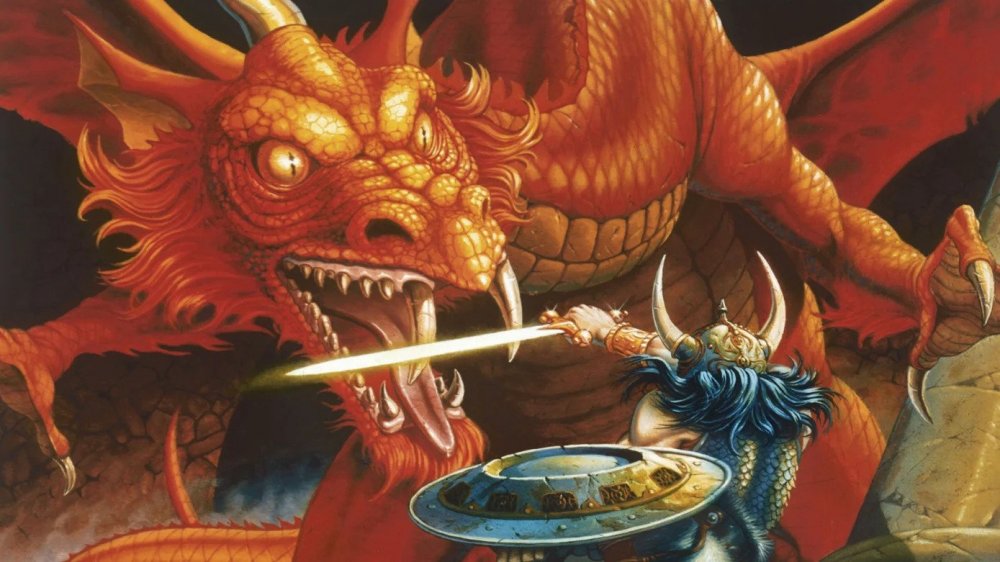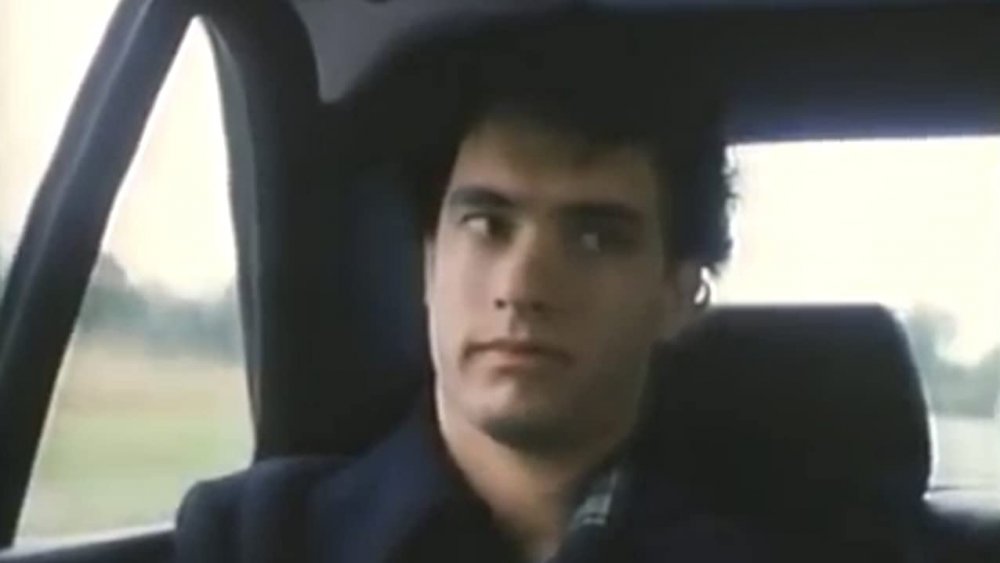The Tom Hanks-Starring Dungeons & Dragons Clone You Never Knew Existed
Tom Hanks is a beloved national treasure, and his phenomenal talent and jaw-dropping range have kept us glued to screens large and small for four decades. There seems to be nothing he can't pull off: from the madcap hilarity of Bachelor Party, to the brooding intensity of Road to Perdition, to the high drama of Cast Away, Hanks is simply a perfect fit for every role in which he's cast, no matter how disparate those roles might be. This is a man who has effortlessly embodied Toy Story's Woody, the simple-yet-astonishingly-complex title character of Forrest Gump, and real-life hero Jim Lovell, the man who saved the crew of Apollo 13 — but every great actor, as they say, has to start somewhere.
In Hanks' case, that starting point was in a bit role in the 1980 slasher flick He Knows You're Alone, which is most remembered (when it's remembered at all) for an infamous scene involving a fish tank (and not, notably, for being the screen debut of one of the greatest actors of his generation). Hanks soon landed a co-lead role on the sitcom Bosom Buddies, which debuted that same year and ran for two seasons — and which raised the young actor's profile enough to land him the lead role on a 1982 CBS television movie entitled Mazes and Monsters.
Now, it doesn't take a particularly sharp set of eyes to notice that this title bears a suspicious resemblance to Dungeons & Dragons, the tabletop role-playing game co-created by the late game designer and amateur strategist Gary Gygax. D&D, as it's affectionately known by its fans, is widely considered to be the first modern RPG (via The New Yorker), and the game that elevated the genre into the cultural force that it became. It was also at the center of one of the most ridiculous controversies of all time, for in the late '70s and early '80s, certain religious and parents' groups became convinced that the game was a sure-fire doorway to Satanism, madness, and death. That's where Tom Hanks comes in.
Dungeons & Dragons started the RPG craze, and also a moral panic
Dungeons & Dragons hit the market in 1974, and sales of the game grew by word of mouth throughout that decade. In 1979, though, the strange disappearance of one young man thrust the game into the spotlight in the worst possible way. In August of that year, James Dallas Egbert III, a Michigan State University student, vanished from campus with nothing but the clothes on his back. Egbert displayed several red flags before his disappearance; an exceptionally smart student, he was also an epileptic, a drug addict who professed to enjoy drugs of his own creation, and a gay man living through a time period when being gay was even less accepted than it is today.
Unfortunately, William Dear, a P.I. hired by Egbert's family, looked straight past all of those markers to zero in on one of Egbert's hobbies: D&D. Dear became convinced that Egbert, detached from reality, had become lost wandering around in character under the university's steam tunnels. This hypothesis disregarded the fact that, well, D&D is played with dice, pencils, and graph paper sitting around a table, not by acting out fanciful situations in real-world locations.
Egbert was found about a month later, unharmed and working on a Louisiana oil rig, of all things (via Skeptical Inquirer). But Dear had spent that entire month playing up the evils of D&D for whatever media outlet would listen, and in the '80s, parental "watchdog" groups never came across a relatively benign youth trend they couldn't paint as the end of Western civilization. The game quickly became a key aspect of that decade's "Satanic panic," during which Old Scratch was accused of infiltrating everything from popular music to preschools to, yes, fantasy role playing games — which, if Mazes and Monsters was to be believed, were capable of rendering their players stone-cold crazy.
Mazes and Monsters was peak anti-D&D hysteria
Mazes and Monsters was based on a 1981 novel of the same name by author Rona Jaffe, who was inspired by the Egbert case. In the film, Hanks stars as Robbie Wheeling, a student at a fictional university who befriends a trio of troubled peers. Robbie had been booted from his previous college because his studies had been pushed to the side in favor of his latest obsession: a fantasy role playing game called (you guessed it) Mazes and Monsters. Robbie's friends are also into the game, and they convince him to pick it back up. Of course, Robbie is soon running games with gusto, and he eventually proposes a new twist: the friends will act out their latest campaign in the unused steam tunnels underneath their school.
During the event, Robbie has a psychotic break, believing himself to actually be his character, who has dreamed of a place he must visit called the Great Hall. In order to find the Great Hall, though, he'll first have to discover the location of the "Two Towers." When Robbie subsequently disappears, his friends put two and two together and follow him — to New York City, where Robbie plans to "cast a spell" while jumping from one of the towers of the World Trade Center. The friends are able to keep Robbie from jumping, but not to pry him from his fantasy world — and at the film's end, it's strongly implied that the kid will be hopelessly insane to the end of his days.
Throughout, Hanks shows several flashes of the undeniable talent which would soon make him a superstar. Understandably, he's never had much to say publicly about Mazes and Monsters — in a 1984 Christian Science Monitor interview, he referred to it only as a "hack-and-slash film." But the flick serves as proof that even in the most little-remembered, ill-advised projects, a future legend might just be lurking.


